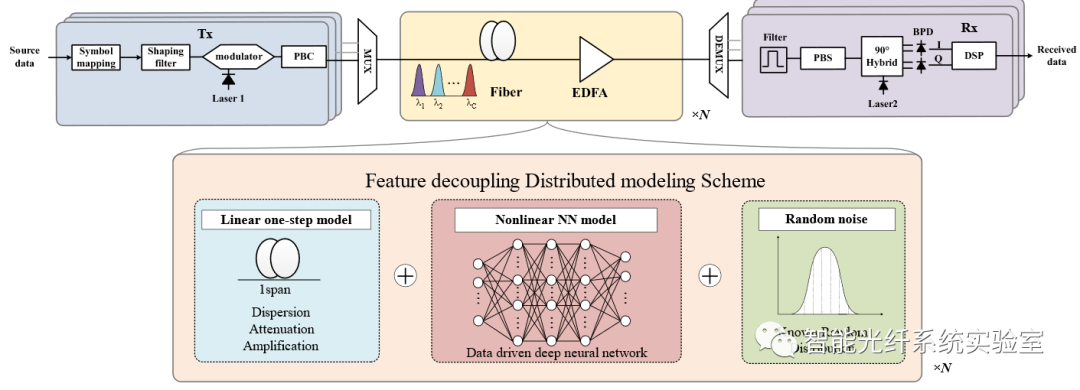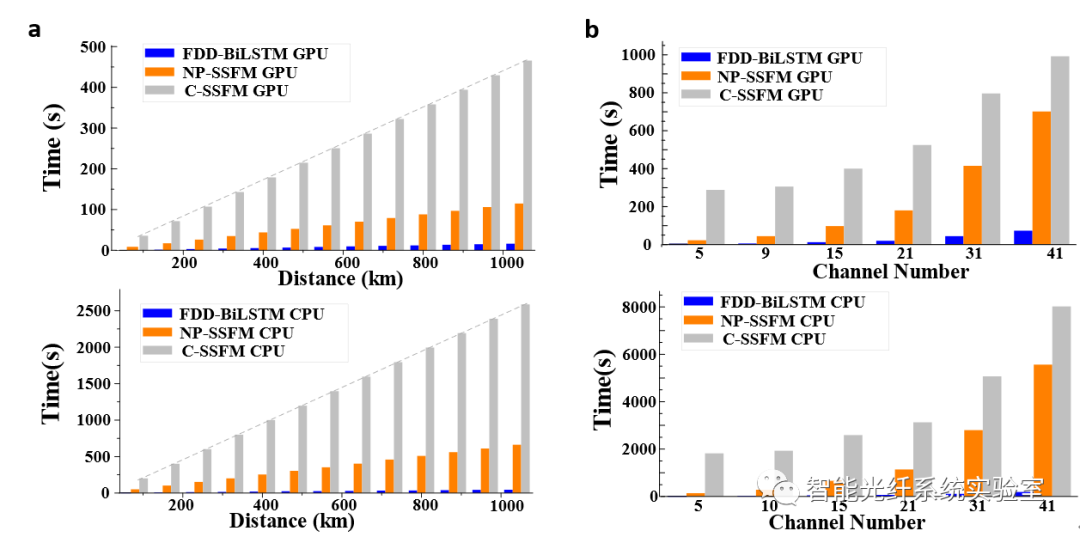Location:Home > News Center >Fast and accura...
Fast and accurate modeling of kilometer wavelength division multiplexing optical fiber communication channel based on model-data hybrid drive

Research Express
Recently, the research group of Professor Lilin Yi from the Department of Electronic Engineering of Shanghai Jiaotong University (LIFE, Laboratory of intelligent fiber ecosystem) proposed a fiber channel modeling scheme based on model-data hybrid drive, which realized the first thousand kilometers of wavelength division multiplexing fiber optic communication channels. Fast and accurate waveform modeling, the running time is reduced by 98% compared with the traditional distributed Fourier method. The relevant results were published in the International Optical Journal "Journal of Lightwave Technology" (early access) in April 2022 under the title "Fast and accurate waveform modeling of long-haul multi-channel optical fiber transmission using a hybrid model-data driven scheme". . Doctoral student Yang Hang is the first author, and Professor Lilin Yi is the corresponding author.
Research Background
Fiber channel modeling is of great significance to the design and optimization of optical fiber communication systems. Accurate fiber channel models can help understand nonlinear complex characteristics, signal transmission responses, and capacity boundaries in optical fibers, so as to achieve the best structural design of optical fiber communication systems. In addition, fast and accurate fiber channel modeling can help researchers quickly evaluate communication algorithms and perform performance predictions, thereby breaking through the limitations of experimental conditions brought about by expensive instruments and equipment, and promoting efficient research and development in the field of fiber optic communications.
Traditional fiber channel waveform modeling is mainly based on the split-step Fourier method (SSFM). This method divides the optical fiber into multiple ultra-short-distance optical fiber lengths, and performs linear and nonlinear feature modeling for each length. Through multiple Step-by-step iterative operation for long-distance fiber channel modeling. For a typical optical fiber communication scenario, that is, long-distance wavelength division multiplexing (WDM) optical fiber transmission, its higher sampling rate and more complex nonlinear characteristics lead to a sharp increase in modeling complexity. Modeling long-distance WDM fiber optic communication via SSFM would take several hours under a single input condition. In order to optimize the system design, multiple rounds of optimization are required by adjusting the system parameters, which will take up to several days, severely limiting the wide application of the channel model. Therefore, fast and accurate long-distance wavelength division multiplexing fiber optic communication channel waveform modeling is very important.
Research Path

Figure 1 Distributed fiber channel modeling scheme based on feature decoupling
In the previous single-wavelength modeling research work, the LIFE research group explored the ability of artificial intelligence technology to model fiber channel characteristics, and verified that the flexible and highly parallel neural network (NN) structure makes fast and accurate channel modeling possible. For long-distance WDM fiber channel scenarios, through a large number of attempts and researches, the main challenges of WDM channel modeling using artificial intelligence technology are determined: (1) Complex nonlinear effects in WDM channels, including cross-phase modulation and four-wave mixing frequency, which puts forward higher accuracy requirements for NN modeling; (2) longer inter-symbol memory length and larger system sampling rate increase the scale of NN structure, which greatly increases the complexity of the model; (3) Analogous to the actual optical fiber link scenario, the model needs to meet the generalization of different conditions, especially the modeling of different distances.
To this end, the LIFE research group proposed a feature-decoupling distributed (FDD) modeling scheme based on feature decoupling. As shown in Figure 1, distributed modeling refers to repeated iterations of a single span (~80 kilometers) model, which is the same as the real link structure, to achieve fiber channel transmission with an integer multiple of any span, and to model long-distance The task of splitting into a single short-distance span iterative operation can simplify the channel characteristics and enable NN to achieve more accurate modeling. The feature decoupling operation separates the channel effects for each span into linear, nonlinear and random noise. Among them, the linear feature is modeled by model-driven, that is, the traditional dispersion modeling scheme is used to realize the direct modeling of the entire span, which greatly reduces the number of iterations; the nonlinear feature is modeled by data-driven NN. We chose and designed Bidirectional long short-term memory structure (BiLSTM), which is good at processing data with temporal memory characteristics, and has higher accuracy for complex nonlinear feature modeling; random noise is regarded as additive noise and is carried out last in each span Add to. Feature decoupling can shorten the time dependence required for nonlinear modeling, avoid a large number of iterative steps, and greatly reduce the complexity of modeling. In addition, due to the extraction of linear features, nonlinear features are enhanced, which improves the accuracy of nonlinear modeling.
Research results

Figure 2 FDD and SSFM modeling results for different Fiber Channel scenarios
The modeling results for different channel conditions are shown in Figure 2, showing the results of the model for different channel numbers, power, modulation formats, and transmission distances. Among them, the output spectrum of FDD in Figure a is highly consistent with SSFM, which proves the modeling ability of the FDD scheme for different channel numbers; Figure b shows the time-domain waveforms of signals with different transmission powers after channel transmission, and the test power is not in the In the training data set, compared with SSFM, the time-domain waveform normalized mean square error of FDD is less than 3.2E-3, which verifies the power generalization ability of the model; the comparison of highly similar constellation diagrams in Figure c shows that the FDD scheme can be realized Generalization to a wide range of modulation formats; Figure d demonstrates that through distributed iterative modeling, the model can generalize over transmission distances.
After verifying the accuracy and generalization ability of the FDD model, we further compared the complexity of different models, and counted C-SSFM (fixed step size), NP-SSFM (variable step size) and FDD-BiLSTM on GPU and BiLSTM respectively. The running time under CPU, SSFM settings with different step lengths have a trade-off between complexity and accuracy. As shown in Figure 3, the running time of FDD-BiSTM is significantly reduced compared with the two SSFM models under different distances and different channel numbers. For the 41-channel signal, through the C-SSFM modeling scheme, the calculation time on the CPU exceeds 2 hours, and the FDD-BiLSTM only needs 3 minutes under the same conditions, achieving 98% complexity optimization compared with the SSFM scheme.

Figure 3 Comparison of running time between FDD and SSFM under different conditions
The FDD modeling scheme accurately and quickly models signal evolution in WDM Fiber Channel. This modeling scheme can accelerate the exploration of nonlinear optical fiber channel capacity, promote the progress of optical fiber nonlinear research, and help realize the global intelligent optimization of optical fiber communication systems, break through the limitations of expensive WDM system equipment, and improve scientific research and production efficiency. In addition, this work provides a reference for the fast numerical solution of nonlinear partial differential equations from the combination of data-driven and model-driven perspectives.
The LIFE research group has been committed to the algorithm design, system architecture design and intelligent development of the optical fiber communication system. At present, the research group conducts in-depth research on fiber channel modeling, constellation shaping design, nonlinear compensation algorithm, and end-to-end performance global optimization based on artificial intelligence methods, and develops an intelligent simulation platform for optical fiber communication systems based on Python to provide sustainable development in the field of optical transmission. Contribute. The work in this direction is supported by the Outstanding Youth Fund of the National Natural Science Foundation of China (62025503), the Key Research and Development Program of the Ministry of Science and Technology (2018YFB1800904), and the Shanghai Jiaotong University-Huawei Advanced Optical Technology Joint Laboratory.

